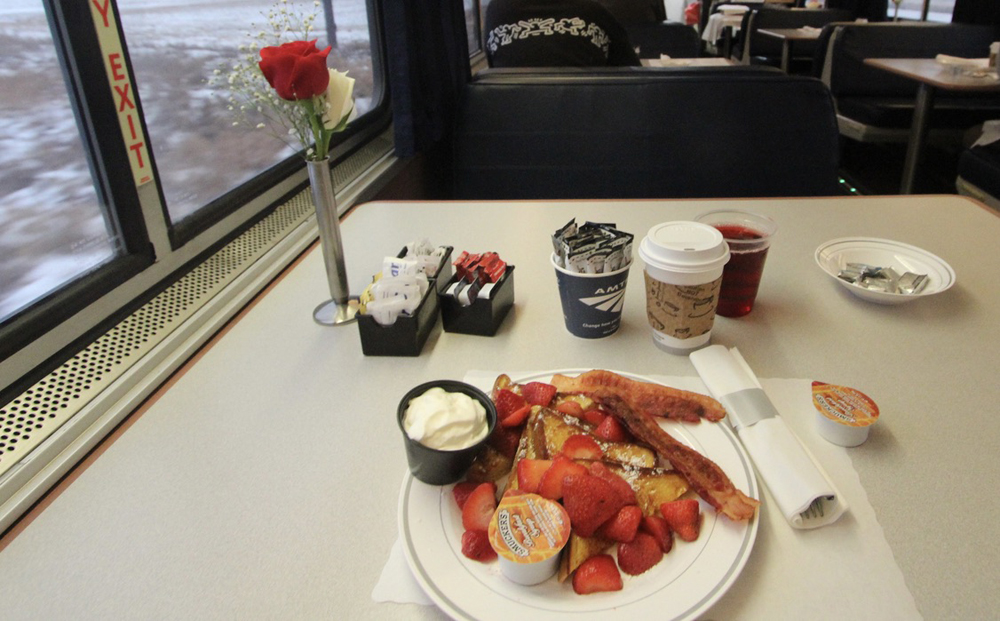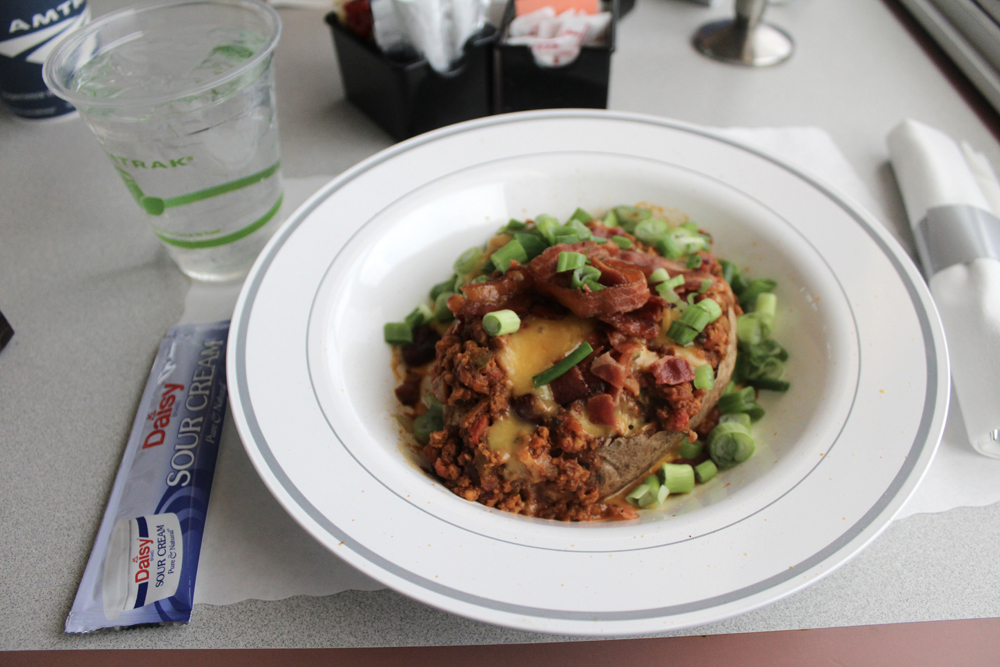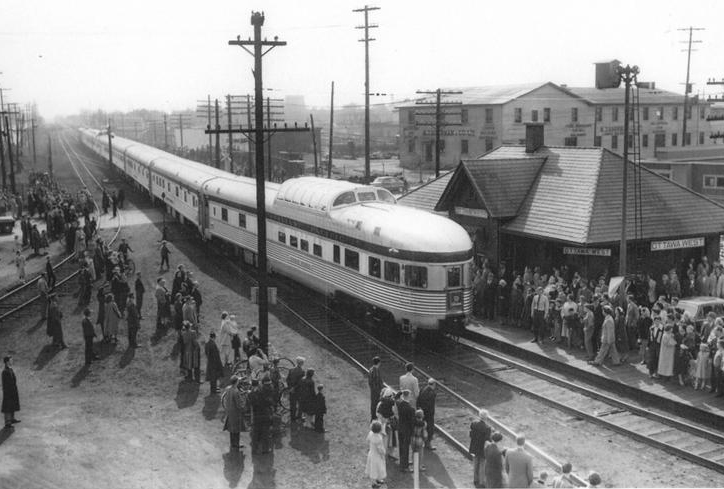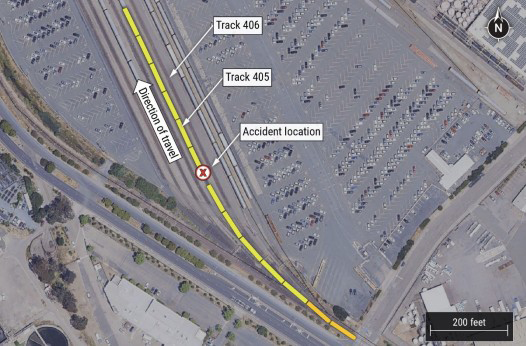
WASHINGTON — Amtrak has begun offering coach passengers on the Empire Builder, California Zephyr, Southwest Chief, Coast Starlight, and Sunset Limited the opportunity to buy meals in those trains’ dining cars, a practice that began March 1.
Since mid-2021, these are the only long-distance trains offering breakfasts, lunches, and dinners prepared to order for sleeping-car passengers; the cost of food and one alcoholic and all non-alcoholic beverages are included in the price of each ticket.
Now, a “limited number of seatings” for breakfast, lunch and dinner are being offered to coach travelers on those trains at a fixed price: $20 for breakfast, $25 for lunch, $45 for dinner, and $20 for all kids’ meals. Amtrak spokeswoman Kimberly Woods tells Trains News Wire, “The onboard purchase comes with the full traditional dining experience —including a complimentary alcoholic drink, complimentary non-alcoholic beverages as well as the bar selection.”
Gradual downgrades to dining
Full-service dining cars offered individually priced meals to all passengers since Amtrak’s 1971 inception. In response to concerns from Congress and the Reagan Administration that the company was losing too much money on food service, in the 1980s Amtrak began including meals in the price of all sleeping-car customers’ tickets, an accounting practice known as “first class transfer.”
After former Delta Airlines chief executive Richard Anderson was hired by Amtrak’s board of directors as president and CEO, in May 2018, onboard meal preparation and staffing was dropped on the Capitol Limited and Lake Shore Limited in favor of pre-packaged food available only to sleeping-car passengers and served in balsa-wood boxes.

“Flexible dining” meals-in-a-bowl, along with the policy of limiting coach passengers to cafe cars, spread to the Crescent, Silver Meteor, Silver Star, City of New Orleans, and Cardinal in October 2019. It was implemented on the Texas Eagle and other western long-distance trains in the summer of 2020, justified by management as a health precaution during the early stages of the COVID-19 pandemic when no vaccines were available.
Once Amtrak brought back dining-car meals on the western trains (except the Eagle) the following year, the company began a “pilot” project of offering Coast Starlight business-class patrons the opportunity to buy meals at a fixed price. With a limited pool of prospective diners and thin dining car staffing, the Los Angeles-Seattle train’s experiment was designed to begin re-establishing what Amtrak had previously hosted before Anderson’s cost cutting.
Some questions remain
While the Coast Starlight template has been extended, exactly how the “limited number of seatings” will be offered could vary on a train-by-train basis. Amtrak’s Woods would only say that “the dining experience for coach passengers will be based on availability.”
Assuming sleeping car travelers get the first pick of lunch and dinner times, it isn’t clear whether coach patrons would be offered vacant early slots or only seats at the last seating. The same is true at “first come, first served” breakfast. How this is handled likely depends on how each train’s dining car lead service attendant assess passenger load and dining car staffing.
As for the possible expansion of traditional dining to the single level New York-Miami Silver Star and Silver Meteor or other trains that still offer only “flexible” meals to sleeping-car passengers, Woods says, “We’ll let you know about changes to dining on the Silver Service should we have something to announce.”














In the short run including the cost of meals in first class fares should be unbundled. It is a poor accounting practice. First class and coach passenegers should be able to book reservations in the dining car on an equal footing. After all, approximately 85% of the passengers on the long-distance trains ride coach.
In the long-run the sleepers and the dining cars should be eliminated. The sleepers should be replaced by business class cars equipped with pods similar to those found on overseas airline flights. The dining cars should be replaced with lounge cars serving an expanded menu. Doing so would result in significant labor savings.
Passengers should be required to pay the full cost of the food service on Amtrak’s trains irrespective of its nature. Requiring taxpayers to subsidize the meals of train riders is beyond the pale.
Mr. Smith, this is the best post on this thread. As a single traveler I resent having to pay the same room charge as do those who are accompanied by someone and for as many as six meals a day depending on the length of the trip. I always eat a good breakfast but tend to skip lunch and have a salad or something light that I brought from home. After all I spend the day sitting in my room with no exercise and that isn’t healthy. Doing away with the diners would be a step in the right direction.
I agree with your take on dining, provided that capacity is met, but I don’t get this newfound advocacy for airline-style pods on trains. A single pod would take up nearly as much space as a roomette, yet only sleep one. It’s a design optimized for weight, not space. And given the tremendous premium airlines charge for them, I wouldn’t expect Amtrak price them lower than its present sleeper options.
Comfortable day and night single occupancy was solved 70 years ago with the slumbercoach, which can be updated and amenified to modern standards. No need to reinvent the wheel into a hexagon.
The news released at the end of last week that Amtrak is finally allowing (a few) coach passengers back into the full service diners on the western routes (except sadly the TEXAS EAGLE) is an obvious “at last” moment. Deep thanks for this accomplishment go to the staff of the Rail Passengers Association–Jim Mathews, Sean Jeans Gail, Slugs (Joe) Aiello and particularly Madison Butler, who have been working tirelessly on this for the past several years. Madison, a highly trained chef, sits on Amtrak’s special food service Working Group–and it is fair and right to further acknowledge that the creation of this body was mandated in language the RPA fought to include in the Amtrak current Amtrak authorizations. They do not consider this the end of the food-service effort and the work continues–as indeed it should.
Now the mixed news. The horrid “Flexible Dining” continues on most eastern long-haul services, as well as the TEXAS EAGLE (although the Florida “Silver Fleet” trains supposedly get chef-prepared food in their diners about March 15–no word yet on coach access on those trains).
Already there is unhappiness about the prices to be charged to coach passengers for for true cooked food in the western diners. Breakfast will be $20, lunch $25 and dinner $45. Meals remain included in the sleeping car fare system-wide.
Candidly I do not find these prices nearly as outrageous as some of us seem to, but they may well discourage coach passengers from indulging in more than one meal on a trip. If the diner experience is intended to be truly special these rates are not any more than I typically pay for a chef-prepared meal here at a restaurant in Vermont. And of course the Amtrak dinner price includes not only a three course meal–but also a complimentary alcoholic beverage of your choice.
Still—-
Better perhaps could be to offer a special seating before the peak dinner hour exclusively for coach riders–with the regular menu supplemented by a more reasonably priced, but limited early dinner entree, as the private carriers used to promote on trains like the pre-Amtrak Santa Fe “El Capitan”. In 1966 $2.10 bought a complete appetizer to desert Salibury Steak dinner.
This coach riders’ “Chef’s Early Dinner” might, for example, provide something like pot roast, or fried chicken in the $25-30 price range. By offering this at an early seating pressure might be relieved on the staff at the more “posh” servings later.
There is a serious “catch” in the new Amtrak coach access policy. No more than 16 coach reservations will be permitted at each meal. This applies to the entire meal time and not just to each seating. This is a bad idea clearly driven by Amtrak’s obsession with cost-cutting by minimizing staff.
Reservations will be required–obviously–to enforce this policy and this is going to create potential on-board confrontations. If the stewards walk through the coaches to take bookings how will they assure that all 16 seats won’t be immediately taken in the first car? If only 8 seats are booked in each of the two coaches Amtrak typically still runs on train like the CZ or the SW CHIEF, will the front seats of each coach get all the slots? Will reservations be taken only in the diner itself, following an announcement on the public address system? What happens when the PA system doesn’t work in one coach? Etc! Of course the diner can’t serve 150 coach riders, but more than 16 wanting to dine is almost certain.
This policy is obviously to reduce pressure on the wait-staff, but an added seating for coach riders might be a far more elegant solution–at least at dinner. And the “no more than 16 coach riders” edict undermines at least some of the goodwill this new opening should generate.
The fact that Amtrak itself made no formal announcement of the new coach diner policy before it was implemented on March 1 sadly speaks yet again to Amtrak’s culture of institutionalized pessimism. There should have been a positive mea culpa advertisement placed on the lines of “We know coach riders were unhappy not to be able to enjoy the dining car. We heard you and it’s Welcome Back!”
For 150 years the railroads provided dining car service to all passengers. The key is to adequately staff the diner. Amtrak clearly is concerned that too many coach dining car takers might overwhelm the (overly) limited food service crew. But instead of so tightly restricting bookings that disappointments will be inevitable, why not try to incentivize coach business in the diner through pricing at least one more reasonably priced offering at each meal and expecting that patronage will follow quality? It certainly should be worth a try!
I do not want to be too harsh here. This policy change is deeply welcomed and despite its strangely silent implementation strategy, it opens the door to restoring a quality on-board experience for all passengers. But until passengers on all overnight/inter-regional (dare I say long-haul) trains can again use both the lounge and dining cars this is a battle won–but not the war.
Riders await news of proper cooked on-board (dining car) food service returning to the LAKESHORE, CRESCENT, CITY OF NEW ORLEANS, CAPITOL LIMITED, TEXAS EAGLE and yes even the tri-weekly CARDINAL. Amtrak is using at peak only 11 of its 25 new Viewliner II diners each night. This speaks volumes to progress yet to be made!
I agree with you. The only solution is pre-ordering. Who wants to be told on a twenty-hour journey that there’s food for some people, not enough food for everyone, depending on who the steward gets to first.
Yes, I remember those diner meals on Amtrak, Chicago to the west coast. That was a half century ago. In the past decade the furthest I’ve traveled by Amtrak is Milwaukee to Mattoon (Illinois). The way things have been going I’m unlikely to go even that far on Amtrak in my remaining years.
If an economy minded family of four traveling by coach from Chicago to Emeryville ate all of their breakfasts, lunches and dinners in the dining car they would spend $600 on meals, not including any kind of tipping. At those prices, I doubt that capacity issues in the dining car related to coach passengers will much of an issue. Though food related trash in the the coaches may be THE issue.
Realistically, a budget-minded family of four will not indulge in dining car meals. They will bring their own snack items and, possibly, buy soft drinks or bottled water on the train.
A step back towards normalcy!
Look, the dining car issue is not rocket science, but only looks confusing when you have neophytes in management making decisions passed through a Board without the relevant experience-and historical perspective-to provide competent stewardship.
Just look back in the 1960s to appreciate the simplicity of dining car operations. For example, the GN and NP served epicurean meals to all comers accommodated in 48-seat diners on the “Empire Builder” and “North Coast Limited.” For dinner, the steward would walk the consist taking reservations to serve both coach and Pullman passengers. The steward controlled liquor sales, as well as collected payment for meals. The western transcons also offered lunch counter/grill/lounges that served decent meals throughout the day, instead of the inferior microwaved frozen crap available in the Sightseer Lounge.
Amtrak needs to cease playing the “shell game” to bury (aka hide) food costs in sleeper fares; willfully discriminate against coach passengers. Indeed, the upper level of Sightseer cars as outfitted with booths could be the designated seating area for coach meals.
Mindful of public health and safety, no passengers should be seated for meals if wearing shower clogs, short shorts, torn t-shirts, or dirty caps. Perhaps even the Pacific Parlour concept could be resurrected to create the ambiance of a lounge and food service for just sleeper passengers; an inviting environment long provided by the railroads?
But who at Amtrak corporate management these days can fully appreciate how the trains were so competently run?
Hey, even in the 1970s AMTRAK knew how to prepare decent meals for all comers. I rode the National Limited from 1973-1975, and always found satisfying meals and excellent service.
Yep, the North Coast Limited had the Lewis and Clark Travellers Rest car and the Builder had the Ranch Car. Both produced high quality meals at a reasonable price..
Friend and I BOTH eat breakfast for $25.00 in a local Diner.
$9.00 aboard United Airlines gets you a serving of good wine and another $9.00 a box of edible “tapas”, which means crackers and raisins. That’s what stuff costs these days when you’re traveling. The wine is half the price on board United than the concessions at the airport.
At those prices, the servings and selection should be plentiful and the food quality top of the line.
Every passenger making a trip on a long distance passenger train should be able to enjoy the thrill and pleasure of having a full course meal in a dining car and enjoying some great food and fine dining. While this experience is not for everybody the passengers who are not able to afford such luxury , it needs to be experienced at least once in their lifetime and when traveling on a long distance train. Several years ago, when Amtrak still had some of the orginal dining cars they inherited from other railroads, I made a reservation with the car attendant for dinner later in the evening and this was while I was traveling down to Florida on the Silver Star. I had a great meal and I had a young couple as my dinner guests who were traveling as far as Jacksonville The food was great and I had a nice meal of steak, mashed potatoes and salad greens and then for dessert a hearty dish of ice cream and ended with a cup of coffee. Later on my return trip to New York aboard the northbound Silver Stat. I enjoyed a great lunch of hamburgers and salad and fries. Great service, friendly and accomodating attendants and it was a great way to meet people and make friends. Of course this was in October 2014 in the pre Richard Anderson era and once he took over, the sky fell down and dining car service ceased and you might say it came off the rails. Now there is a semblance of dining car service but it can and never will be like the good old days. But whether you buy meals or food in the snack car or are a sleeping car passenger with dining car privileges the food served and bought on the train is far superior and puts airline food to shame. Never fly on an airplane or a long flight with a big appetite or feel hungry you will starve on what they will serve you.
Joseph C. Markfelder
I think the fixed price is a good compromise as it eliminates the stingy coach passenger from taking up space in the expensive dining car and only ordering a salad and a soda. So now the coach passengers are at the same fixed level pricing as the sleeping car passengers. So the more they can seat the better the performance of the dining car financially. It’s like adding more sleeping cars to the consist meal price wise.
I will continue to say Amtrak should allow passengers to book meals along with their travel and be paid for at time of booking. You then have an idea of demand. Then place a limited amount of extra meals in inventory to sell to those who buy tickets before train time or for those on the train who decide at the last minute for a meal in the diner. Some airlines now one has to book and pay for a meal with their reservation.
Good point. It quantifies demand and will have less waste.
James, you and I have been saying this same thing for at least a decade now if not longer. I’ve been saying since the clowns in D.C. first said food service was a loss leader for Amtrak.
Agreed.
What Amtrak is doing now sounds like a lottery. Maybe we’ll sell you a full meal, but we probably won’t.